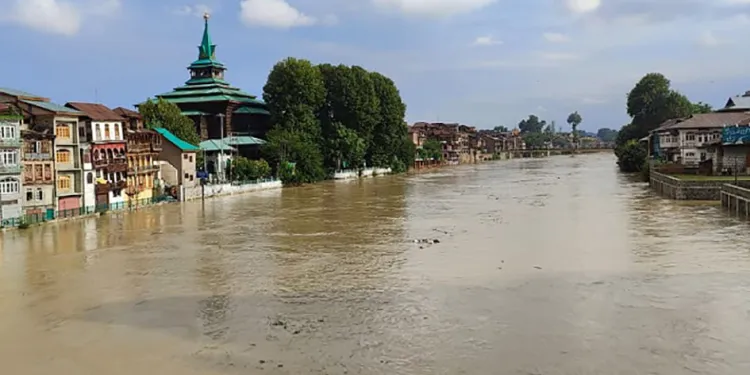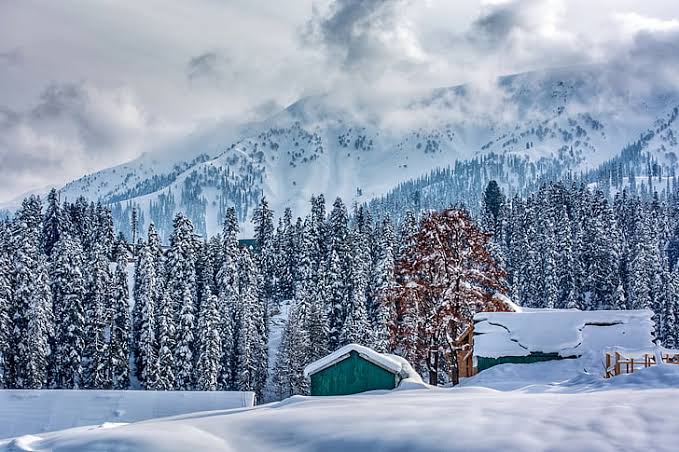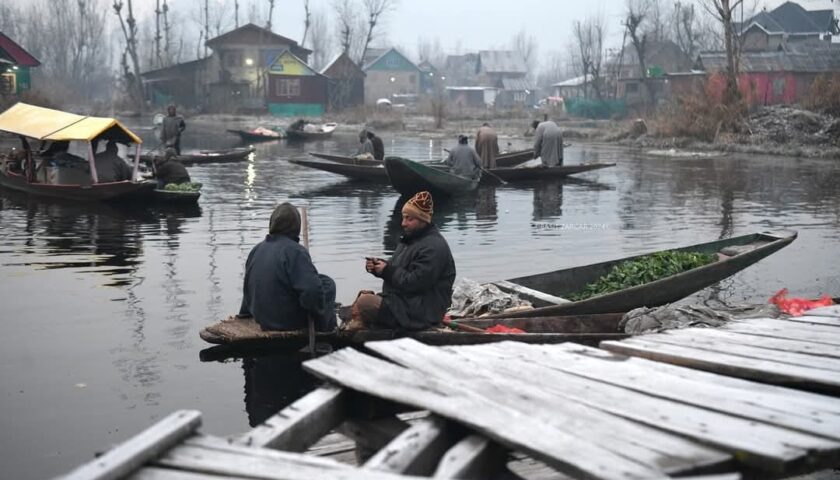A Valley on Edge: Seventh Flood Scare Since 2014
By: Javid Amin | 08 September 2025
In early September 2025, as the Jhelum River surged past danger marks at Sangam and Ram Munshi Bagh, sirens blared across Srinagar. Mosque loudspeakers echoed warnings. Families in Bemina, Jawahar Nagar, and other low-lying neighborhoods rushed to shift valuables to higher floors.
It was a chilling déjà vu. This was Kashmir’s seventh major flood scare since 2014, when devastating waters displaced nearly one million people, submerged large parts of Srinagar, and left scars that have yet to heal.
Despite ₹1,500 crore investments through the Jhelum and Tawi Flood Recovery Project (JTFRP) and the Comprehensive Flood Management Plan (CFMP), Kashmir remains dangerously exposed. Each year, panic outweighs preparedness.
Geography of Vulnerability: A Bowl with No Drain
The Valley’s very shape conspires against it.
-
The Jhelum River, flowing from Verinag to Wular Lake, has low natural carrying capacity.
-
At Sangam, the danger mark is 25 feet; in 2014, waters rose to 34.7 feet.
-
At Ram Munshi Bagh, danger is 21 feet; in 2014, it touched 29.5 feet.
-
Once the river breaches, the bowl-shaped Valley traps water with no outlet, turning cities and villages into inland lakes.
-
Tributaries like Vishow, Lidder, Rambiara, and Doodh Ganga add to the surge, overwhelming embankments.
This geography + neglect equation makes Kashmir among the most flood-prone regions in South Asia.
Urban Expansion: Nature’s Buffers Paved Over
Kashmir’s natural flood-absorbing systems—wetlands, flood channels, and riverbanks—have been steadily destroyed.
-
Hokersar Wetland, once a vast sponge, is now choked with encroachments.
-
Wular Lake, Asia’s largest freshwater lake, has shrunk due to siltation and construction.
-
Flood spill channels lie clogged with debris and garbage.
What replaced these buffers?
-
Housing colonies on floodplains.
-
Shopping complexes on riverbanks.
-
Roads and highways cutting across water flow paths.
Each illegal construction narrows Kashmir’s resilience, and each rainy season exposes the cost of short-sighted “development.”
Promises That Sank with the Water
After 2014, leaders pledged a flood-resilient Kashmir:
-
Dredging the Jhelum to increase capacity.
-
Strengthening embankments to prevent breaches.
-
Restoring wetlands as natural shields.
-
Installing real-time flood warning systems.
-
Ensuring quick compensation and rehabilitation.
But reality is stark:
-
Dredging stalled after initial enthusiasm.
-
Embankments remain fragile, with breaches reported annually.
-
Wetlands continue to shrink under political patronage.
-
Warning systems fail, often delayed or inaccurate.
-
Compensation is inconsistent, leaving victims in despair.
Even CM Omar Abdullah admitted recently:
“It seems that 11 years have been wasted by previous governments. Questions need to be asked about what has been done in the last 11 years.”
Media’s Role: Panic or Preparedness?
Another danger in Kashmir is misinformation during crises.
-
Social media influencers livestream chaos, spreading unverified rumors of dam breaches or earthquakes.
-
Shouting reporters turn alerts into theatre, amplifying panic instead of guiding people.
-
Clickbait headlines spread faster than the Jhelum itself.
The result?
-
Distrust in genuine alerts.
-
Overcrowding in wrong shelters.
-
Confusion during evacuations.
In disasters, information can save lives. In Kashmir, misinformation multiplies risk.
Floods & Farmers: Kashmir’s Rice Bowl Under Water
This year, while Srinagar city exhaled as waters receded, South Kashmir’s farmers mourned.
The districts of Kulgam and Anantnag—the Valley’s rice bowl—reported 60–90% crop loss.
👨🌾 Muhammad Shafi Ganai, farmer from Khudwani:
“I can only eat what’s left. I won’t be able to sell anything. How will I pay for my children’s education?”
👨🌾 Mehraj Ahmad Mir, Batengoo:
“First drought, now floods. We cannot sell a single grain. This is our only income.”
Without crop insurance, timely compensation, or alternative livelihoods, Kashmir’s rural backbone stands broken. A looming food crisis stares the Valley in the face.
The High Court Steps In: A Judicial Wake-Up Call
Amid this chaos, the Jammu & Kashmir and Ladakh High Court has intervened decisively.
Hearing a PIL filed by the Environmental Policy Group (EPG), the Division Bench led by the Chief Justice expressed grave concern over administrative failures.
The court reviewed EPG Convenor Faiz Bakshi’s six-page urgent report, which highlighted:
-
Alarming administrative inertia.
-
Weak flood-control mechanisms.
-
Rampant encroachments on wetlands and water bodies.
-
Grave deficiencies in preparedness risking lives, property, and ecology.
Officials in the Dock
The High Court has summoned three top bureaucrats to appear in person:
-
Commissioner Secretary, Irrigation & Flood Control
-
Commissioner Secretary, Housing & Urban Development
-
Divisional Commissioner, Kashmir
They must submit an Action Taken Report (ATR) by September 9, detailing measures to safeguard the Valley.
For the first time in years, bureaucrats face personal judicial accountability for flood preparedness.
EPG’s Recommendations: A Science-Based Roadmap
The EPG report proposed bold, actionable steps:
-
Ban construction within 500 meters of wetlands.
-
Reassess encroaching projects like Rakh Arth Colony, Transworld University, and IIM Srinagar.
-
Create small water storages and hybrid pumped-storage systems to regulate floods and address power shortages.
-
Empower experts over politicians in disaster management.
Its warning was blunt:
“Those qualified to act are not empowered, while those empowered lack the will to act.”
What Needs to Change: A Reformist Roadmap
To prevent another catastrophe, experts insist Kashmir must move from speeches to solutions:
✅ Infrastructure Overhaul
-
Complete dredging of Jhelum and tributaries.
-
Strengthen embankments with modern tech.
-
Expand urban drainage systems.
✅ Wetland Restoration
-
Reclaim Hokersar, Wular, and flood spill channels.
-
Enforce a ban on construction in floodplains.
-
Incentivize eco-restoration projects.
✅ Real-Time Monitoring
-
Install automated flood gauges.
-
Launch mobile alert systems.
-
Train local disaster-response teams.
✅ Policy & Accountability
-
Transparent audits of JTFRP and CFMP funds.
-
Public dashboards on preparedness.
-
Civil society participation in planning.
Editorial Takeaway: The Time for Action Is Now
Kashmir’s flood vulnerability is not just natural—it is man-made. Encroached wetlands, weak embankments, failed dredging, and unchecked urbanisation are political choices.
The High Court’s intervention is a judicial reckoning for 11 wasted years. If its summons leads to genuine accountability, this could mark a turning point in Kashmir’s disaster governance.
The water is rising. The warnings are clear. The Valley cannot afford another 2014.




